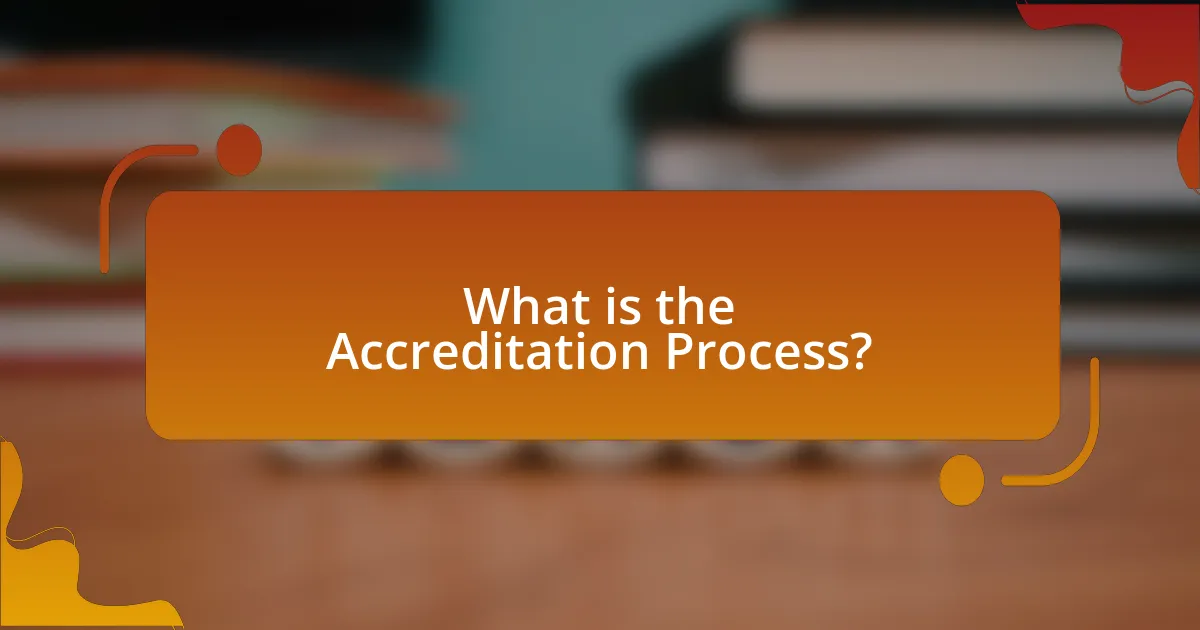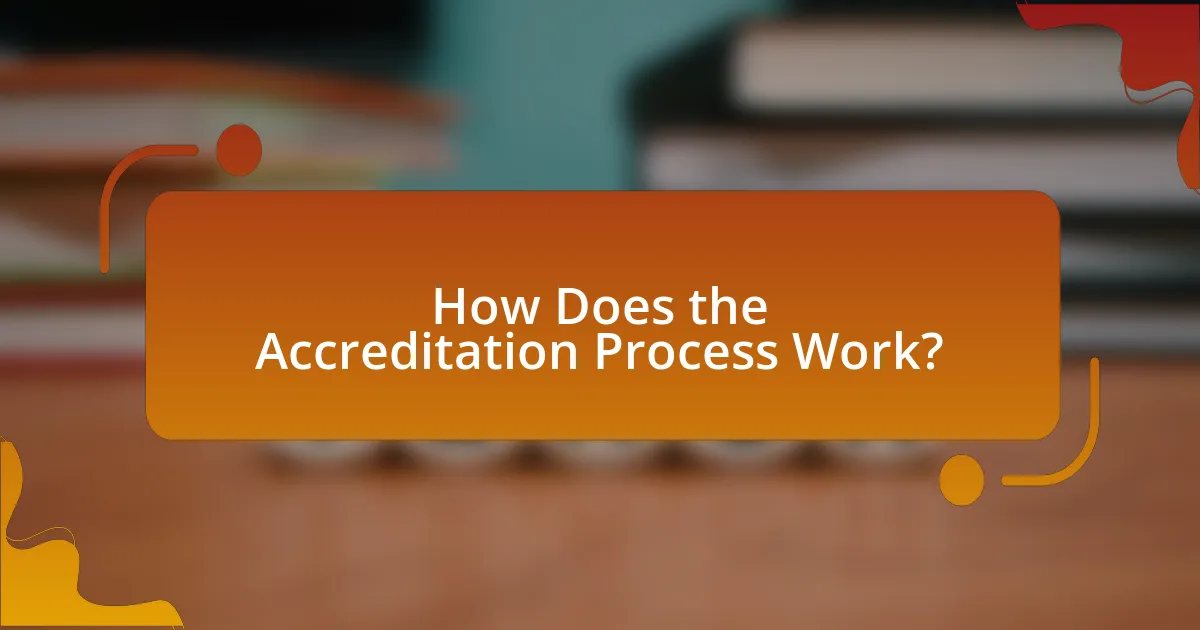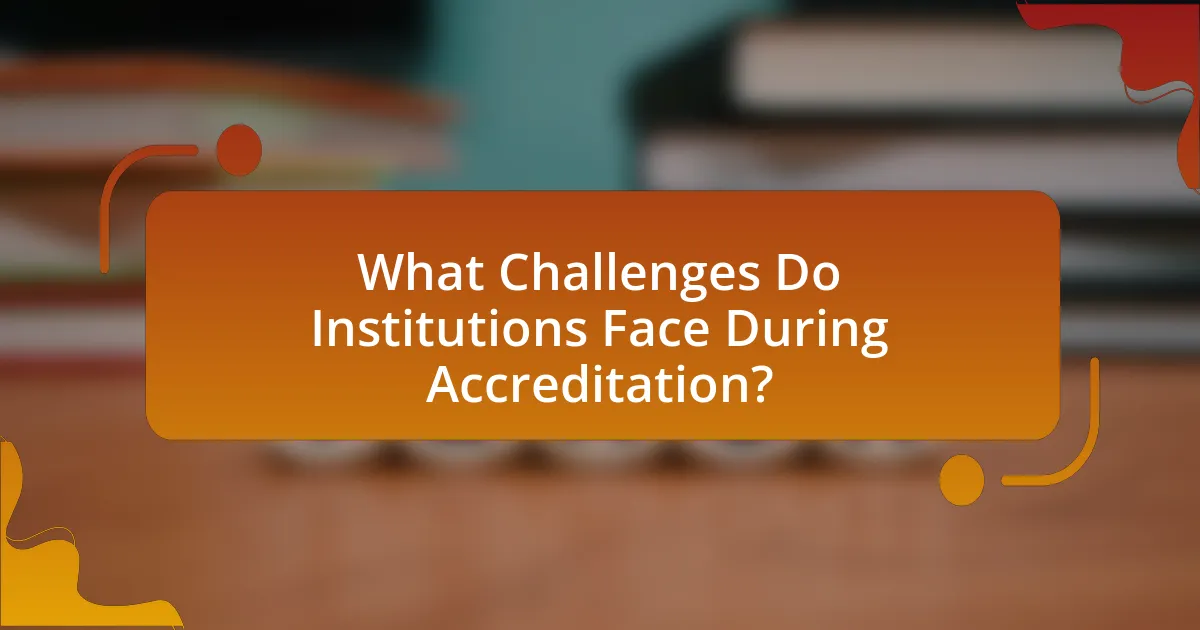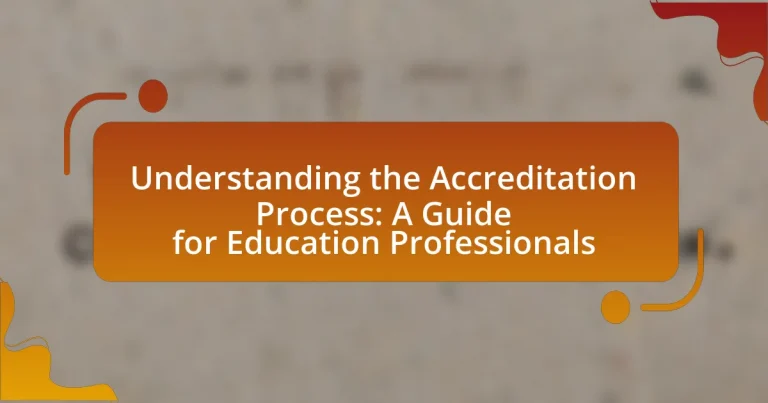The article provides a comprehensive overview of the accreditation process in education, detailing its significance, types, and the steps involved. Accreditation is defined as a systematic evaluation of educational institutions or programs to ensure they meet established quality standards, which enhances credibility and student outcomes. Key topics include the importance of accreditation, the roles of stakeholders, challenges faced by institutions, and best practices for successful accreditation. Additionally, the article outlines resources available for education professionals navigating the accreditation landscape, emphasizing the need for thorough preparation and stakeholder engagement.

What is the Accreditation Process?
The accreditation process is a systematic evaluation of educational institutions or programs to ensure they meet established standards of quality and effectiveness. This process typically involves self-assessment by the institution, followed by an external review conducted by a recognized accrediting body. The accrediting body assesses various factors, including curriculum, faculty qualifications, student outcomes, and institutional resources, to determine compliance with specific criteria. Accreditation serves to validate the institution’s commitment to continuous improvement and accountability in education, ultimately enhancing the credibility of the institution and the value of its degrees.
Why is Accreditation Important in Education?
Accreditation is important in education because it ensures that institutions meet specific quality standards, which enhances the credibility of their programs. Accredited institutions are regularly evaluated against established benchmarks, ensuring that they provide a level of education that is recognized and respected. For example, in the United States, the Council for Higher Education Accreditation (CHEA) oversees the accreditation process, which helps students and employers identify programs that meet rigorous academic and professional standards. This validation not only aids students in making informed choices about their education but also increases their employability, as employers often prefer graduates from accredited programs.
What are the key benefits of accreditation for educational institutions?
Accreditation provides educational institutions with enhanced credibility and recognition, which is essential for attracting students and faculty. It ensures that the institution meets established standards of quality and effectiveness, thereby fostering trust among stakeholders. Accreditation also facilitates access to federal and state funding, as many financial aid programs require accredited status. Furthermore, it promotes continuous improvement through regular evaluations, helping institutions to identify areas for enhancement and maintain educational excellence. According to the Council for Higher Education Accreditation, accredited institutions are more likely to have better student outcomes, including higher graduation rates and job placement statistics.
How does accreditation impact student outcomes?
Accreditation significantly enhances student outcomes by ensuring that educational institutions meet established quality standards. Accredited programs often lead to higher graduation rates, improved job placement rates, and better overall student satisfaction. For instance, a study by the Council for Higher Education Accreditation found that institutions with accreditation had graduation rates that were 10-20% higher than those without. This correlation indicates that accreditation not only validates the quality of education but also fosters an environment conducive to student success.
What are the Different Types of Accreditation?
The different types of accreditation include institutional accreditation, programmatic accreditation, national accreditation, and regional accreditation. Institutional accreditation evaluates the entire institution’s quality and effectiveness, while programmatic accreditation focuses on specific programs or departments within an institution. National accreditation is typically granted to vocational and technical schools, whereas regional accreditation is awarded to colleges and universities in specific geographic areas. According to the Council for Higher Education Accreditation, regional accreditation is generally considered more prestigious and is often required for federal financial aid eligibility.
What is institutional accreditation?
Institutional accreditation is a formal recognition process through which an educational institution is evaluated and certified as meeting specific standards of quality and effectiveness. This process typically involves a comprehensive review by an accrediting body, which assesses various aspects of the institution, including its mission, governance, academic programs, and student services. Accreditation serves to ensure that institutions provide a level of education that meets established benchmarks, thereby enhancing the credibility of the institution and its programs. For example, in the United States, regional accrediting organizations evaluate institutions based on criteria set forth by the Council for Higher Education Accreditation, ensuring that accredited institutions maintain high educational standards.
What is programmatic accreditation?
Programmatic accreditation is a specialized form of accreditation that evaluates specific academic programs within an institution rather than the institution as a whole. This type of accreditation ensures that a program meets established standards of quality and effectiveness, often set by professional organizations relevant to the field of study. For example, the Accreditation Board for Engineering and Technology (ABET) accredits engineering programs, ensuring they meet industry standards. This process involves rigorous assessments, including curriculum review, faculty qualifications, and student outcomes, to validate that the program prepares students adequately for their professional careers.

How Does the Accreditation Process Work?
The accreditation process involves a systematic evaluation of an educational institution or program to ensure it meets established standards of quality and effectiveness. This process typically includes self-study by the institution, peer review by external evaluators, and a decision by an accrediting body based on the findings. For instance, the U.S. Department of Education recognizes various accrediting agencies that assess institutions against specific criteria, ensuring compliance with educational standards. This structured approach helps maintain educational integrity and provides assurance to students and stakeholders regarding the quality of education offered.
What are the Steps Involved in the Accreditation Process?
The steps involved in the accreditation process typically include self-study, application submission, peer review, site visit, and decision-making. Initially, the institution conducts a self-study to evaluate its programs and practices against established standards. Following this, the institution submits an application to the accrediting body, which includes documentation of compliance with accreditation criteria. Next, a peer review team, composed of experts in the field, evaluates the application and conducts a site visit to assess the institution’s operations and quality. After the site visit, the peer review team submits a report to the accrediting body, which then makes a decision regarding accreditation status based on the findings. This structured process ensures that institutions meet specific educational standards and maintain quality in their programs.
How do institutions prepare for accreditation reviews?
Institutions prepare for accreditation reviews by conducting comprehensive self-assessments to evaluate their compliance with accreditation standards. This process typically involves gathering data on institutional performance, engaging faculty and staff in discussions about strengths and weaknesses, and aligning programs with the accrediting body’s criteria. For example, institutions often create a detailed self-study report that documents their mission, goals, and outcomes, demonstrating how they meet the required standards. This preparation is crucial, as it not only helps institutions identify areas for improvement but also ensures they present a clear and organized case to the accrediting agency, ultimately enhancing their chances of successful accreditation.
What role do self-studies play in the accreditation process?
Self-studies are critical in the accreditation process as they provide a comprehensive evaluation of an institution’s programs, policies, and practices. This internal assessment allows institutions to identify strengths and weaknesses, ensuring alignment with accreditation standards set by governing bodies. For instance, the Council for Higher Education Accreditation emphasizes that self-studies facilitate continuous improvement and accountability, which are essential for maintaining accreditation status. By systematically analyzing their operations, institutions can demonstrate their commitment to quality education and readiness for external review, ultimately influencing the accreditation decision.
Who are the Key Stakeholders in the Accreditation Process?
The key stakeholders in the accreditation process include educational institutions, accrediting agencies, government bodies, faculty members, students, and employers. Educational institutions seek accreditation to validate their programs and enhance their credibility. Accrediting agencies evaluate these institutions based on established standards and criteria. Government bodies may regulate or recognize accrediting agencies, ensuring compliance with educational standards. Faculty members contribute to the self-study and evaluation processes, while students provide feedback on their educational experiences. Employers often rely on accreditation to assess the quality of graduates from these institutions, ensuring that they meet industry standards.
What is the role of accrediting agencies?
Accrediting agencies evaluate and ensure the quality of educational institutions and programs. Their role includes establishing standards for educational quality, conducting assessments to determine compliance with those standards, and providing recognition to institutions that meet or exceed the criteria. For example, the Council for Higher Education Accreditation (CHEA) oversees the accreditation process in the United States, ensuring that accredited institutions maintain educational integrity and accountability. This process helps students and employers identify credible and high-quality educational offerings.
How do faculty and administration contribute to the process?
Faculty and administration contribute to the accreditation process by ensuring compliance with established standards and facilitating continuous improvement. Faculty members engage in curriculum development, assessment of student learning outcomes, and provide evidence of academic quality, while administration supports these efforts through resource allocation, policy development, and strategic planning. For instance, faculty often participate in self-study reports that demonstrate how programs meet accreditation criteria, while administration coordinates the logistics of the accreditation review process, ensuring that all necessary documentation is prepared and submitted on time. This collaborative effort is essential for maintaining institutional credibility and enhancing educational quality.

What Challenges Do Institutions Face During Accreditation?
Institutions face several challenges during accreditation, including meeting rigorous standards, resource allocation, and maintaining stakeholder engagement. Meeting rigorous standards requires institutions to demonstrate compliance with specific educational criteria, which can be complex and time-consuming. Resource allocation challenges arise as institutions must invest significant time and financial resources to prepare for the accreditation process, often diverting attention from other critical areas. Additionally, maintaining stakeholder engagement, including faculty, staff, and students, is crucial, as their support and involvement are necessary for a successful accreditation outcome. These challenges are well-documented in studies, such as the report by the Council for Higher Education Accreditation, which highlights the resource-intensive nature of the accreditation process and the importance of institutional commitment to achieving and maintaining accreditation status.
What Common Pitfalls Should Institutions Avoid?
Institutions should avoid inadequate preparation for accreditation reviews. Insufficient documentation and lack of alignment with accreditation standards can lead to negative evaluations. For instance, a study by the Council for Higher Education Accreditation found that institutions lacking comprehensive self-assessment reports often faced delays or denials in accreditation. Additionally, failing to engage stakeholders, such as faculty and students, in the accreditation process can result in a lack of support and understanding of the institution’s mission and goals, further jeopardizing accreditation outcomes.
How can institutions effectively address resource limitations?
Institutions can effectively address resource limitations by implementing strategic resource allocation and fostering partnerships. Strategic resource allocation involves prioritizing essential programs and services based on institutional goals, which can enhance efficiency and reduce waste. For instance, a study by the National Center for Education Statistics found that institutions that regularly assess their resource distribution can improve operational effectiveness by up to 20%. Additionally, fostering partnerships with local businesses and community organizations can provide access to additional funding and resources, as evidenced by collaborative initiatives that have successfully increased resource availability in various educational settings.
What strategies can be employed to improve compliance with standards?
To improve compliance with standards, organizations can implement comprehensive training programs for staff. These programs ensure that all employees understand the standards and their importance, leading to better adherence. Research indicates that organizations with structured training see a 30% increase in compliance rates, as employees are more informed and engaged in the accreditation process. Additionally, regular audits and feedback mechanisms can identify areas of non-compliance, allowing for timely corrective actions. By fostering a culture of accountability and continuous improvement, organizations can significantly enhance their compliance with established standards.
How Can Institutions Ensure a Successful Accreditation Outcome?
Institutions can ensure a successful accreditation outcome by implementing a comprehensive self-assessment process that aligns with accreditation standards. This involves regularly reviewing and documenting compliance with the specific criteria set forth by the accrediting body, which typically includes aspects such as educational quality, institutional effectiveness, and resource allocation.
For instance, a study by the Council for Higher Education Accreditation highlights that institutions that engage in continuous improvement practices and maintain open communication with accrediting agencies tend to achieve higher success rates in accreditation reviews. Additionally, involving faculty and staff in the accreditation process fosters a culture of accountability and shared responsibility, which is crucial for meeting the required standards.
What best practices should be followed during the accreditation process?
Best practices during the accreditation process include thorough preparation, stakeholder engagement, and continuous improvement. Thorough preparation involves gathering necessary documentation and data to demonstrate compliance with accreditation standards. Engaging stakeholders, such as faculty, staff, and students, ensures that diverse perspectives are considered, fostering a culture of accountability and transparency. Continuous improvement focuses on using feedback from the accreditation process to enhance educational programs and institutional effectiveness. These practices are supported by research indicating that institutions that actively involve their community and prioritize quality improvement achieve higher accreditation success rates.
How can institutions engage stakeholders throughout the process?
Institutions can engage stakeholders throughout the accreditation process by implementing structured communication strategies and involving them in decision-making. Regular updates through meetings, surveys, and feedback sessions ensure stakeholders are informed and can contribute their perspectives. For instance, the Council for Higher Education Accreditation emphasizes the importance of stakeholder involvement in accreditation, stating that effective engagement leads to improved outcomes and accountability. By fostering a collaborative environment, institutions can enhance transparency and build trust, ultimately leading to a more successful accreditation process.
What Resources are Available for Education Professionals Navigating Accreditation?
Education professionals navigating accreditation can access various resources, including accreditation bodies’ official websites, professional organizations, and online training programs. Accreditation bodies, such as the Council for the Accreditation of Educator Preparation (CAEP) and the National Council for Accreditation of Teacher Education (NCATE), provide guidelines, standards, and documentation essential for the accreditation process. Professional organizations, like the American Association of Colleges for Teacher Education (AACTE), offer workshops, webinars, and networking opportunities that facilitate understanding of accreditation requirements. Additionally, online platforms such as Coursera and edX provide courses specifically focused on accreditation processes, enhancing knowledge and skills relevant to achieving accreditation. These resources collectively support education professionals in successfully navigating the complexities of accreditation.
Where can professionals find guidance and support for accreditation?
Professionals can find guidance and support for accreditation through various organizations and resources dedicated to the accreditation process. Key sources include the Council for Higher Education Accreditation (CHEA), which provides information on accreditation standards and practices, and the U.S. Department of Education, which offers resources on recognized accrediting agencies. Additionally, professional associations related to specific fields often have accreditation resources and support networks. These organizations provide essential information, best practices, and networking opportunities to help professionals navigate the accreditation process effectively.
What tools and templates can assist in the accreditation process?
Tools and templates that assist in the accreditation process include accreditation self-study templates, compliance checklists, and data management software. Accreditation self-study templates provide a structured format for institutions to document their adherence to standards, ensuring all necessary information is organized and easily accessible. Compliance checklists help institutions track their progress against accreditation requirements, allowing for systematic evaluation of readiness. Data management software facilitates the collection and analysis of relevant data, which is crucial for demonstrating compliance and effectiveness in meeting accreditation standards. These tools enhance efficiency and accuracy in the accreditation process, ultimately supporting institutions in achieving and maintaining accreditation status.
What Tips Can Help Education Professionals Succeed in Accreditation?
Education professionals can succeed in accreditation by thoroughly understanding the accreditation standards and actively engaging in the self-study process. Familiarity with the specific criteria set by accrediting bodies, such as the Council for the Accreditation of Educator Preparation, ensures that institutions align their programs with required benchmarks. Additionally, forming a dedicated accreditation team can facilitate collaboration and accountability, leading to a more organized approach to gathering evidence and documentation. Regularly reviewing and updating program materials to reflect current practices and outcomes is essential, as it demonstrates a commitment to continuous improvement. Engaging stakeholders, including faculty, students, and community members, in the accreditation process fosters a culture of transparency and support, which is crucial for meeting accreditation requirements.


